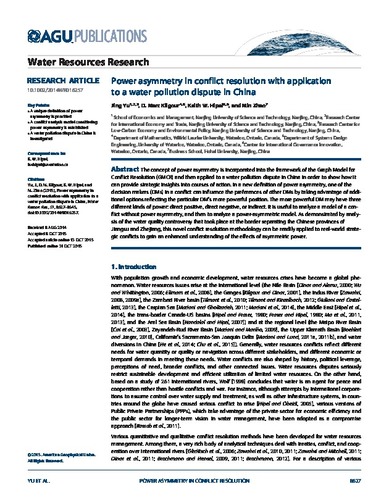| dc.contributor.author | Yu, Jing | |
| dc.contributor.author | Kilgour, D. Marc | |
| dc.contributor.author | Hipel, Keith W. | |
| dc.contributor.author | Zhao, Min | |
| dc.date.accessioned | 2018-04-19 20:54:28 (GMT) | |
| dc.date.available | 2018-04-19 20:54:28 (GMT) | |
| dc.date.issued | 2015-10-01 | |
| dc.identifier.uri | http://dx.doi.org/10.1002/2014WR016257 | |
| dc.identifier.uri | http://hdl.handle.net/10012/13139 | |
| dc.description | © 2015. American Geophysical Union. All Rights Reserved. This is the peer reviewed version of the following article:Yu, J., Kilgour, D. M., Hipel, K. W., & Zhao, M. (2015). Power asymmetry in conflict resolution with application to a water pollution dispute in China. Water Resources Research, 51(10), 8627–8645, which has been published in final form at https://doi.org/10.1002/2014WR016257 | en |
| dc.description.abstract | The concept of power asymmetry is incorporated into the framework of the Graph Model for Conflict Resolution (GMCR) and then applied to a water pollution dispute in China in order to show how it can provide strategic insights into courses of action. In a new definition of power asymmetry, one of the decision makers (DMs) in a conflict can influence the preferences of other DMs by taking advantage of additional options reflecting the particular DM's more powerful position. The more powerful DM may have three different kinds of power: direct positive, direct negative, or indirect. It is useful to analyze a model of a conflict without power asymmetry, and then to analyze a power-asymmetric model. As demonstrated by analysis of the water quality controversy that took place at the border separating the Chinese provinces of Jiangsu and Zhejiang, this novel conflict resolution methodology can be readily applied to real-world strategic conflicts to gain an enhanced understanding of the effects of asymmetric power. | en |
| dc.description.sponsorship | National Natural Science Foundation of China [71471087] | en |
| dc.description.sponsorship | Natural Sciences and Engineering Research Council of Canada | en |
| dc.language.iso | en | en |
| dc.publisher | Wiley | en |
| dc.subject | Decision-Support-System | en |
| dc.subject | Status-Quo Analysis | en |
| dc.subject | Graph Model | en |
| dc.subject | Environmental Conflict | en |
| dc.subject | Coalition Analysis | en |
| dc.subject | River Conflict | en |
| dc.subject | Middle-East | en |
| dc.subject | Cooperation | en |
| dc.subject | Basin | en |
| dc.subject | Management | en |
| dc.title | Power asymmetry in conflict resolution with application to a water pollution dispute in China | en |
| dc.type | Article | en |
| dcterms.bibliographicCitation | Yu, J., Kilgour, D. M., Hipel, K. W., & Zhao, M. (2015). Power asymmetry in conflict resolution with application to a water pollution dispute in China. Water Resources Research, 51(10), 8627–8645. https://doi.org/10.1002/2014WR016257 | en |
| uws.contributor.affiliation1 | Faculty of Engineering | en |
| uws.contributor.affiliation2 | Systems Design Engineering | en |
| uws.typeOfResource | Text | en |
| uws.typeOfResource | Text | en |
| uws.peerReviewStatus | Reviewed | en |
| uws.scholarLevel | Faculty | en |

